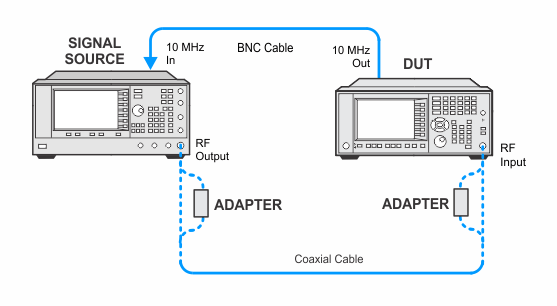Effective DANL Option NFE/NF2 Functional Test
This test applies to the following models with Option NFE or NF2:
|

|
-
Option NF2 will be functionally tested to a limit that is 3 dB below the DANL specification. Option NFE will be tested to the specification as listed in the “Version-Dependent Backdated Specifications” chapter of the PXA Specifications Guide.
-
If the Effective DANL test should fail, Option NF2 requires a manual noise floor characterization. To do this, press System > More > Advanced > Characterize Noise Floor. For Option NFE, refer to the Effective DANL Adjustment .
|
Option NFE/NF2 provides noise corrections which will allow the signal analyzer
to measure signals close to the noise. The corrections will essentially
compensate for the known conversion loss of the signal analyzer RF front-end.
The noise floor improvement is inferred from amplitude measurements
made on a signal close to the noise floor. The test is actually three
measurements that are performed at each test frequency. The choice of
test frequency was center of the band offset by 100 MHz times Pi. This
frequency offset was done to avoid measuring residuals.
Measurement 1 (M1) — This is
a DANL measurement made in a 300 kHz resolution bandwidth. The goal of
this measurement is to baseline the noise of the DUT. The test signal
amplitude will be placed approximately 5 dB above the measured noise floor.
Measurement 2 (M2) — The test
signal amplitude is calculated from the DANL measurement. This step measures
the amplitude of the test signal in the 30 Hz resolution bandwidth. The
30 Hz resolution bandwidth will provide a 40 dB improvement in SNR. The
goal of this measurement is to baseline the true amplitude of the test
signal.
Measurement 3 (M3) — The resolution
bandwidth is set to 300 kHz and the amplitude of the signal (plus noise)
is measured with the noise corrections set to On. The 300 kHz resolution
bandwidth causes the SNR to be around 5 dB. The amplitude difference relative
to the M2 measurement is the noise contribution.
The "effective noise, Neff" can be calculated from the results
of these three measurements:
M1 = Uncorrected Noise (in watts) = N
M2 = Amplitude of signal with high SNR (in watts) = A
M3 = Amplitude of signal with low SNR (in watts) = A + Neff
Neff = A – (A + Neff)
Neff = M2 – M3
Let’s state this as a ratio because then
we can easily calculate the relative improvement in terms of dB:
Noise Improvement (Linear) = Neff/N = (M2-M3)/M1
Noise Improvement (dB) = 10 x LOG(Neff/N) = 10 x LOG [(M2-M3)/M1]
The Effective DANL can be calculated by the following equations:
Effective DANL (dBm/Hz) = Uncorrected Noise (300 kHz RBW) + Noise Improvement (dB) + 1 Hz RBW Normalization
Effective DANL (dBm/Hz) = 10 x LOG(M1/.001) + 10 x LOG [(M2-M3)/M1] + 10
x LOG (300000)
Where: 10 x LOG (30000) normalizes the result to a 1 Hz resolution bandwidth.
Click here for troubleshooting.
Required Test Equipment
|
Test Equipment
|
Recommended Model Number
|
|
Microwave Signal Generator #1
|
PSG Models
(see equipment list)
|
|
BNC Cable
|
8120-1840
|
|
Coaxial Cable, 3.5 mm
|
11500E
|
|
Coaxial Cable, 2.4 mm
|
8120-6164
|
|
3.5 mm (f) to 3.5 mm (f) adapter
(for 3.5 mm source)
|
83059B
|
|
Type-N (m) to 3.5 mm (f) adapter
|
1250-1744
|
|
2.4 mm (f) to 3.5 mm (f) adapter
(for 2.4 mm source)
|
11901B
|
Connection Setups
Effective DANL Test Setup




